


Here we go, the beginning of the playoff round in earnest. Every one of the leaders present in this game have finished either first or second in the earlier group stage of matches. We have three very dominant winners from their respective games, two of them winning via Domination, along with three runner up leaders of varying strength. Let's meet our returning contestants.

Suryavarman has been waiting in the wings for ages, all the way since Game One. Back in that initial match, he had a tough central starting position surrounded by other AI leaders on all sides. The Buddhist and Hindu holy cities even popped up right on the borders of Khmer territory, stealing more tiles away from Suryavarman's control. Despite that seeming handicap, Suryavarman was able to go on to the attack and reach a position of strength. He took out Ramessess first, and then ended the game by crushing Napoleon in a ruthless show of strength. It was one of the best AI performances we saw in the opening round of games. Suryavarman has one of the best trait pairings in the game with Creative/Expansive traits, and his Khmer civilization brings the Ballista Elephant and Baray. As an AI, Suryavarman has gold and culture flavors. He emphasizes wonders quite a bit (8/10 rating), but also has a decent unit emphasis rating, and asks for help frequently. Anyone who turns down Suryavarman's many requests gets a special -2 diplo penalty, similar to the one that exists for Catherine AI. Suryavarman is well above average in aggression rating at 7.6 out of 10, and he's rated very low on the peace weight scale as an "Evil" leader. He's one of the most miliaristic of the leaders with good economic traits, making for a dangerous opponent.

Huayna Capac returns as the winner from Game Four, where he took our first Domination victory of the competition over a field of crazy warmongers. This was the game where Huayna was up against Shaka, Montezuma, and Genghis Khan, and he bested all of them in the end. Huayna played the diplomatic situation very well in that match, letting other leaders exhaust themselves in unproductive wars and then sweep in to grab all the spoils at the end. Once they grew big, there was no stopping the Incans. Huayna Capac benefits from having some outstanding traits with the Financial/Industrious pairing, and his Incan civ has the strong Quechua along with the best unique building in Civ4, the Terrace. Huayna is often considered to have the best restricted combination of leader and civilization in the game. As an AI, Huayna has gold and production flavors. He also loves to build wonders (8/10 rating) but has a bit less emphasis on units compared to Suryavarman. Huayna places a high emphasis on religion, and with his Mysticism starting tech, he's likely to found Buddhism or Hinduism. He's a bit above average in aggression rating (6.7 out of 10) and also gets rated as an "Evil" leader via peace weight. I'm starting to notice a pattern here of AI leaders with strong economic traits who are also very willing to go to war. That may be the winning formula for AI behavior.

Catherine is back again after her own Domination victory in Game Seven. This was perhaps the most impressive win of the opening round, since Catherine killed off all competitors other than her Russian partner, Stalin. Only two survivors from that bloodbath of a game! Catherine declared war against all five of the other leaders in that particular match, and showed her willingness to attack anyone and everyone in order to get what she wanted. Catherine has the trait comination of Creative and Imperialistic, one that's well suited for gaining an edge early and then snowballing to victory. Her Russian civ has the Cossack and Research Institute unique items. As an AI, Catherine has culture and military flavors. She has extremely high ratings in the asking for help (10/10) and demanding tribute (8/10) categories, and any refusal to accept those demands carries a special -2 diplo penalty. As I mentioned in the earlier Game Seven writeup for Catherine, she has the AI personality of the obsessive high-maintenance girlfriend, always demanding something, never explaining her actions. Catherine AI is also slightly above average in aggression rating (6.7 out of 10) and she too gets rated as an "Evil" leader according to peace weight. Like Suryavarman and Huayna, Catherine can declare war at "Pleased" relations. These three leaders are going to be something to watch in this one.

Justinian is the first of our runner up leaders, finishing second to Mansa Musa in Game Two. He was written off by many in that game due to his tundra start in the far north, but Justinian managed to make himself a major contender through his cataphract-fueled conquest of Hatshepsut. That said, it does bear mentioning that Justinian only took second place due to the collapse of Mehmed in that game. He was lucky that Mansa Musa was on the other side of the world! Anyway, Justinian is noticeably weaker in terms of traits compared to our first three leaders, with Spiritual and Imperialistic for his pairing. This may be why Justinian finished second and not first. His Byzantine civilization has a key trump card in the form of the Cataphract unique unit, probably the second or third best in the game. The Byzantines also have the Hippodrome, not that anyone cares about that. Justinian AI uses religious and military flavors for research. He is obsessed with religion, and has a high chance of founding an early faith due to Byzantium's Mysticism starting tech. Justinian has a high unit emphasis (8/10) and he isn't afraid to declare war, with his 7.6 aggression rating. Justinian gets rated as a "Neutral" leader according to peace weight, albeit one that leans slightly towards the evil side. Expect Justinian to stir up plenty of trouble with his religious focus and his cataphracts.

Augustus was one of the less memorable leaders from the opening round. He finished second to Lincoln in Game Five, and largely earned his spot by virtue of surviving a series of attacks from Ragnar in the early stages of the game. Augustus made a lot of people sad in the picking contest, where Ragnar was a massive favorite to top the board as the winner of that contest. It did feel as though his runner up position was somewhat of a break of good luck, and I have to say that Augustus was a lot less impressive than some of the other leaders here. Who knows though, maybe he'll show us all in this one. Augustus has the somewhat weak pairing of Imperialistic and Industrious traits. He does get the Roman civilization, however, with its awesome Praetorians (and less awesome Forums). Augustus the AI has production and military flavors. He loves to build wonders (8/10 rating) and otherwise has fairly average scores across the board. Augustus is significantly less aggressive than the rest of this crowd, with a rating of only 4.6 out of 10. He's also considered to be a "Good" leader via peace weight, which could be extremely dangerous given the field of leaders in this game. Augustus may be a marked man amongst his neighbors. The deck is certainly stacked against him in this one.

Cyrus returns from a solid showing in Game Eight, where he finished second to Mao Zedong as sort of a right-hand man to the Chinese leader. Cyrus spent much of that game fighting wars on the other side of the map, contesting cities in German territory thousands of miles away from home. He never spent much effort on the Carthaginians right next door, despite the fact that they each founded separate religions. It was a bizarre game for diplomacy. Cyrus wasn't especially impressive in that game, but he managed to survive over the course of 430 turns of brutal warfare to make it into these playoff rounds. Cyrus has Charismatic and Imperialistic traits, making four leaders in this game sharing Imperialistic. Maybe that one really does help the AI? His Persian civilization has the Immortal and Apothecary unique items, neither one particularly impressive. Cyrus AI uses military and growth flavors. He's another leader with a wonder fetish (8/10) who is otherwise fairly average in ratings. Like most of these leaders, Cyrus is above average in aggression, with a score of 7/10. He's another "Neutral" leader, but like Justinian, a neutral peace weight that leans towards the evil side in alignment. We'll see what Cyrus can make of himself in this match.
* * * * * * * * * * * * * * * * * * * * * * * * * * * * * *
With only a few games left to go, the stakes are higher than ever for this contest. Suryavarman, Huayna Capac, and Catherine all played extremely strong games in their first apperances. Their AI personalities look remarkably similar, leaders with good economic traits who are very willing to go to war and carve our larger empires for themselves. All of them can also declare war at "Pleased" relations; for that matter, Catherine can even be bribed into a war against leaders with whom she has "Friendly" relations! Despite their past performances, however, only two of them can move on to the Championship game. Who's going to finish in first and second place? And can one of the three runner up leaders rise up and grasp one of those spots for themselves? They'll have an uphill task (especially poor Augustus) but it's certainly not impossible. The playoffs are underway!
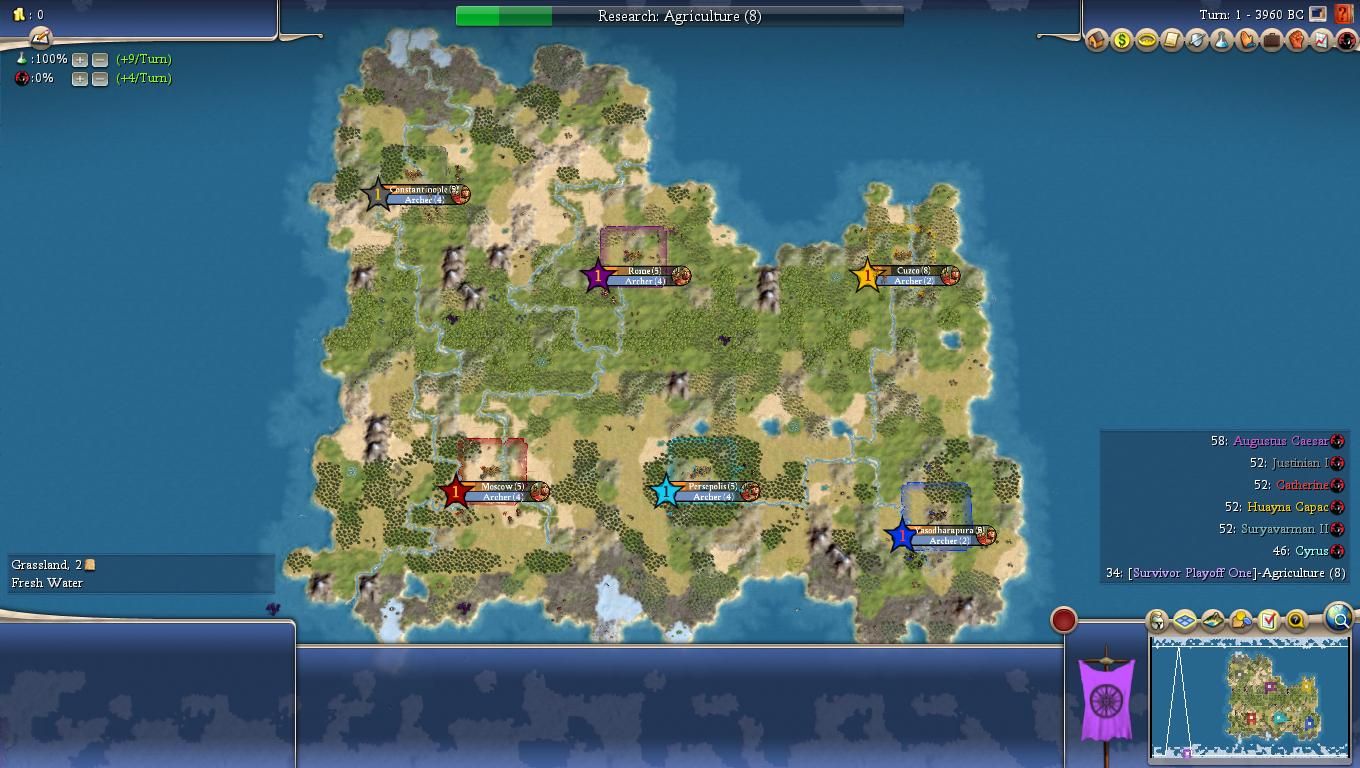
I rerolled maps for quite some time looking for something that was roughly fair to all competitiors. Eventually I ended up with this map, one that was among the smallest I'd seen but looked to be generally balanced between the AIs. I thought that this was maybe slightly in favor of Catherine and Justinian because there was a bit more land in the west, but it was good enough for our purposes. You can never get a perfectly fair setup when using random maps. The continent looked particularly small coming on the heels of the Large map used in the Wildcard game. This would be much more intimate, with a lot more early contact. With four Imperialistic leaders, this map was going to fill up very quickly.

Here's where the AIs sent their Deity starting settlers. The east was going to get even more cramped given the chosen position for those cities, with Persian and Incan and Khmer borders practically on top of one another. I noticed that Justinian sent his settler further up into the tundra in a show of silliness, although he did claim a copper resource there at least. Both Justinian and Huayna were racing for Meditation tech, and who got the religion was going to come down to a dice roll. Huayna was the lucky winner, and this turned his second city of Tiwanaku into the Buddhist holy city. That seemed like a huge deal given how tightly contested that eastern area looked to be. Justinian went for Polytheism immediately, and he would found Hinduism in his northwest tundra city a few turns later. The Buddhist and Hindu holy cities were about as far apart as possible on this continent.
Justinian was the first to get out a third city, which he pushed due south towards Catherine. If he'd sent his initial starting settler in that direction, and then had Hinduism pop up in the city, it would have been a lot rougher going for Cathy. As it was, much of the free Hindu culture was being wasted up in the arctic. The other leaders soon followed suit, pushing out their own third cities. Catherine was expanding north and east, doing a smart job with her early placements, letting her Creative culture push the other leaders around. Several leaders went after Stonehenge, but it was Suryavarman who landed it:
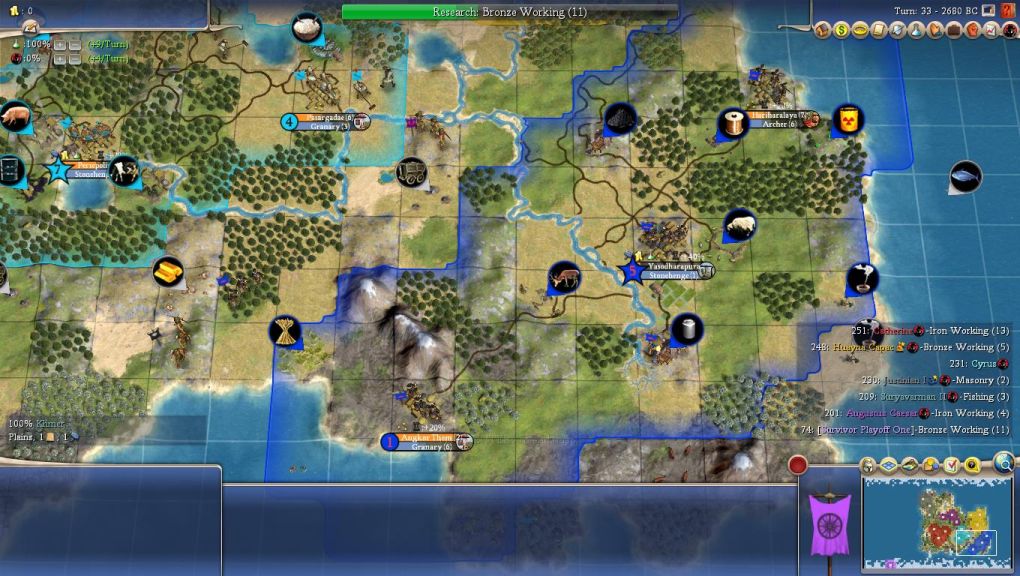
He'd gotten himself boxed into the southeast corner of the map, as a result of the Buddhist holy city to the north and the aggressive placement of Pasargadae by Cyrus to the northwest. Suryavarman was going to have to make a move here somewhere or else he'd be relegated to a non-entity in this game.
Not much happened for a while. The AI leaders were still in the expansion phase, filling up the vacant parts of the map with their settler swarm. Cyrus built the Great Wall, beating out competition from two or three other leaders. Suryavarman researched his way to Monotheism, eventually founding Judaism and providing a third major world religion. This seemed all but destined to spark a war with the Buddhist Incans just to the north. There were further border tensions over in the west:
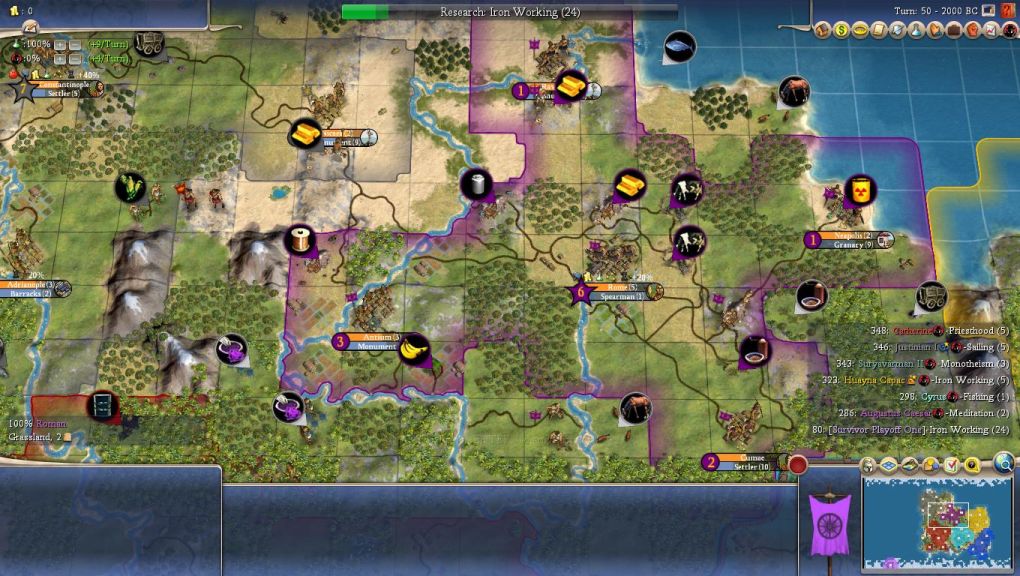
Justinian's city of Nicaea seemed all but certain to stir up trouble with Augustus, once the borders expanded on both sides. Someone was going to be very unhappy over there and start grabbing for their swords. Further south, Cyrus planted the city of Ecbatana a mere three tiles east of one of Catherine's cities. The Persian city didn't even control its own first ring tiles! Cyrus must have been desperate to expand to consider a location like that. Pressure was building everywhere on the map. With this bunch of leaders, it couldn't last too much longer before the first shots were fired.
In another surprising twist, Augustus built the Oracle and used it to take Code of Laws as his free tech. None of the AIs had done anything like this in the prior games, it wasn't what I was expecting at all. He founded Confucianism and of course converted to the religion the next turn. Now we had FOUR major world religions in operation: the Incan Buddhists, Byzantine Hindus, Khmer Jews, and the Roman Confucianists. What a strange mix. Catherine had converted to Hinduism for the moment, and Cyrus was the only remaining pagan.
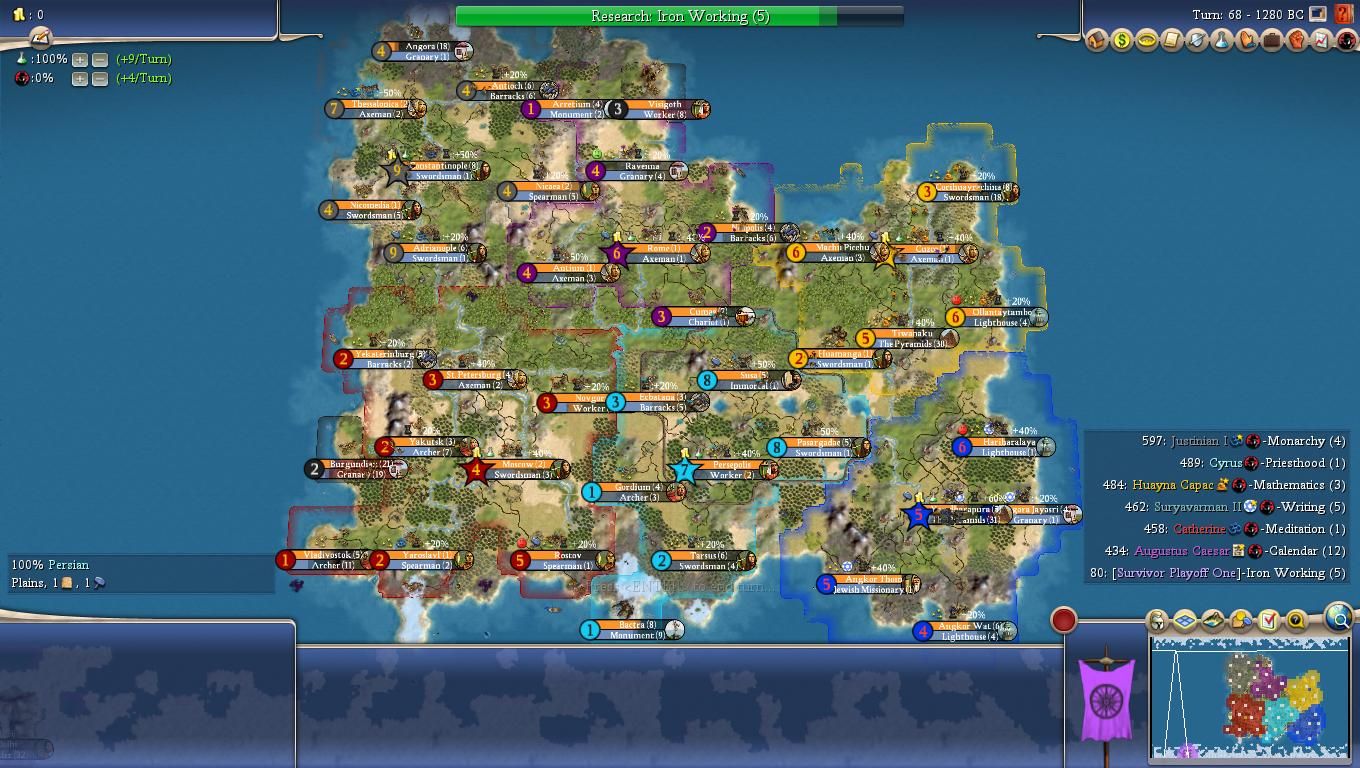
The world map was essentially full after about 65 turns. The AI leaders had been cramming cities into every nook and cranny that they could find, leaving almost nothing left to this point. There were a couple of barb cities, and that was essentially it. The early game score leader was a surprising Justinian. This was mostly due to him having several happiness resources in his territory: gold, ivory, and furs. Along with his self-founded religion and cheap Spiritual temples, this allowed him to grow his cities to larger sizes compared to the other AIs. Many of the other leaders needed Calendar tech to access their luxuries. After Justinian, everyone was fairly bunched together on the scoreboard. Suryavarman had been squeezed the most on land, but Cyrus and Augustus had done surprisingly well for themselves. I did not think that the Persians would end up with so many cities. Catherine was in good position, however she wasn't running away with this one. At least not yet. Catherine was badly lacking in happiness resources, which was why her cities were all so small. She was hooking up her ivory now, and then she needed to get to Calendar tech for her spices and silks.
If you look at the city builds in that overview shot, quite a few leaders were pumping out units in preparation for conflict. I normally try to do the big pictures on round turn numbers, but I had no choice for this one. It was extremely obvious that the first war of the game was going to begin on the next turn:
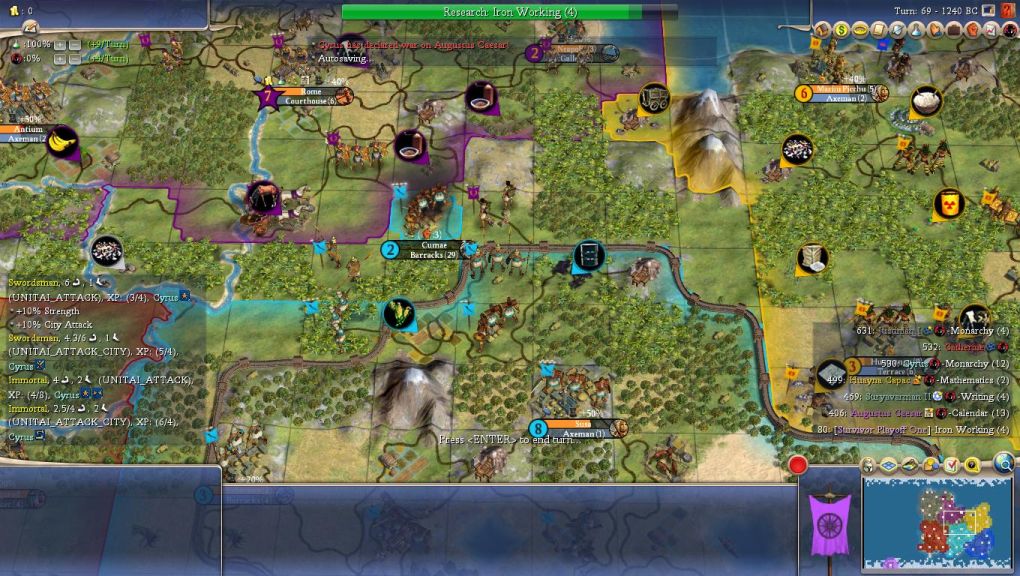
Cyrus had eight units right on the Roman border, and that could only mean one thing. Cumae didn't even control its own first ring of tiles, making this attack very easy to pull off. Poor Augustus had massive peace weight issues, and he had erred greatly by founding his own religion. Everyone else disliked him for those two reasons. I'm not exaggerating here - all five other leaders were "Annoyed" with Augustus. Furthermore, in another tough break for the Romans, there was no iron anywhere in the surrounding region. Huayna's culture had just nipped the closest source. No iron, no praetorians. This didn't bode well for Augustus' long term survival in the center of the map, surrounded on all sides by potential enemies.
Of course, with no catapults around to deal with heavy cultural defenses, Cyrus had no chance to capture much of anything from Augustus beyond that initial border city. The Persians took a stab against the capital city of Rome, and it went about as well as you'd expect when attacking with swords and axes into 40% cultural defenses. Augustus happily took the free Great General created by that dismal failure of an assault. The main thing that Cyrus had accomplished was the complete pillaging of southern Roman territory, something that was of dubious benefit. While this was going on, the barbarian city of Visigoth actually culture flipped to Augustus! It was only three tiles away from the Confucian holy city at Ravenna, and the culture eventually overwhelmed the barb defenders. Augustus certainly needed any breaks of luck he could get right now.
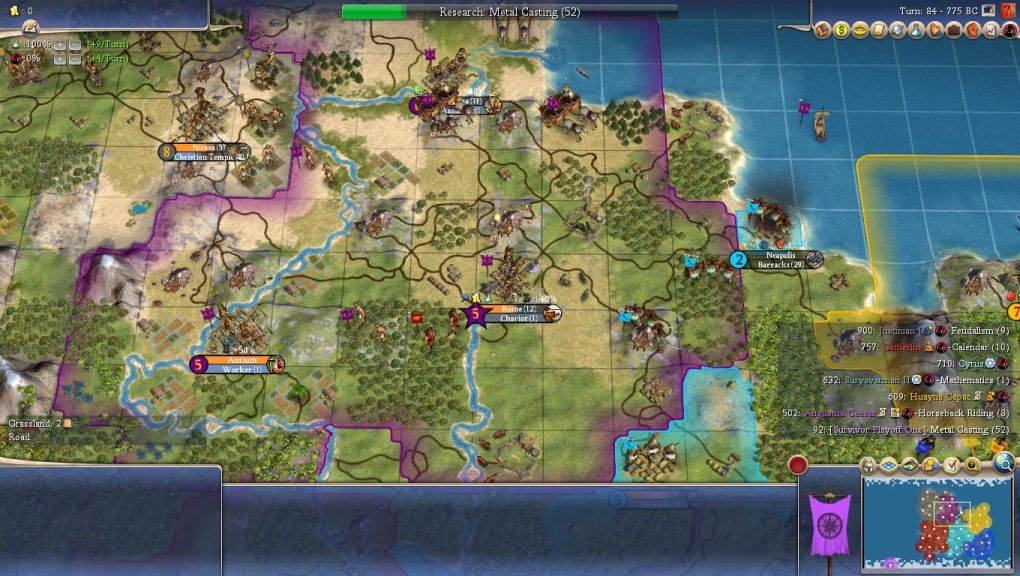
Surprise, surprise: Cyrus managed to pick off another city on the northern coast a few turns later. I didn't think he'd get much more out of this war until he finished Construction tech, but the Persian leader was able to take Neapolis without catapults. Augustus was in terrible shape now, and it looked like only a matter of time until Justinian joined the conflict as well. There was massive border overlap in the north between Rome and Byzantium, plus clashing religions, plus peace weight differences. I was kind of surprised that Justinian hadn't attacked already. However, it wasn't Justinian who joined in the Roman war next, but Huayna Capac. He sent in a ministack with five units inside, which would have done nothing, except that one of those five units was a catapult. That single unit began the torturously slow process of bombing down the defenses of the city of Rome, four percent damage per turn.
While all this warring was taking place in the center of the map, Huayna Capac had built the Great Lighthouse and Suryavarman won a tight race to the Pyramids. Despite the wonder, the Khmer leader remained in Despotism for the moment. Uh, ok? Then I finally got to take the screenshot I'd been waiting to see for some time:

Justinian entered the war against Augustus. I mean, this had to happen, right? There was no avoiding this. Just look at their shared border region up there in the north, cities planted right on top of one another. With diametrically opposed alignment and competing faiths, this was a certainty. You can only flip a coin so many times before you get "Tails" as a result. In any case, the units of three nations now converged on poor Augustus. Justinian wisely had his main army up in the north, where they overran Arretium in the opening turns of the struggle. They pushed on next to Ravenna and took it almost without breaking a sweat. Huayna and Cyrus both had large armies outside of the city of Rome, each with about two dozen units inside, waiting for the Incan catapults to finish taking down the defenses before storming the walls. In a few more turns, the culture would be completely gone and the attack would begin. Then Catherine ALSO declared war on Augustus, looking for her own share of the spoils. Holy dogpile, Batman!
How screwed was Augustus right now?
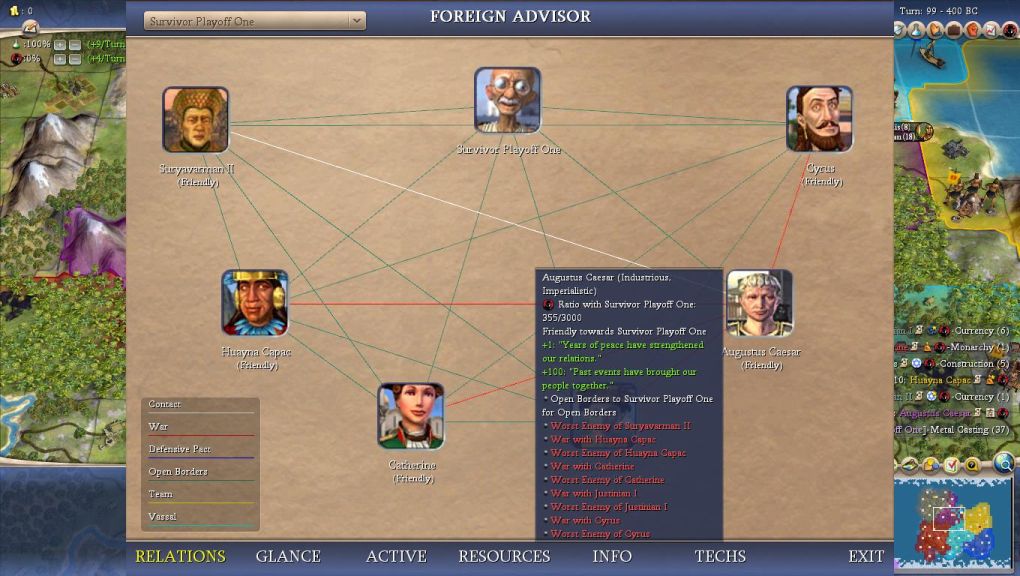
Pretty freakin' screwed. 
There was no doubt now that Augustus was going to be the first to die. The real issue was what spoils each of the other leaders would get in the aftermath of Rome's destruction. Huayna unfortunately came out terribly in this regard; it was his catapults that did all the hard work of dropping the defenses of the city of Rome, and he led the first attack on the city that killed about two thirds of the defenders. However, this also destroyed the Incan stack completely, leaving Huayna with nothing for all of his hard efforts. That was a tough break, he'd have been in a vastly stronger position if he could have taken the city of Rome and gotten out of that northeast corner. Instead it was the other leaders who profited the most. Justinian was able to take the former barb city of Visigoth, giving him complete control over the northern edge of the map and extending his score lead further. Catherine captured Antium, pushing her borders further to the northeast into the center of the map. Her late invasion allowed her to take a valuable prize at virtually no cost, a typical move from Catherine. And Cyrus gained the largest prize of all, taking the Roman capital for himself:

Look at poor Huayna's stack on the next tile over, having done so much work and obtained nothing! Poor guy. We should give credit where credit is due though. Cyrus was the first one to start the war against Augustus, and it was a gutsy move to do so. Cyrus started the game in a cramped position with neighbors on all sides, and he must have realized that he had to do something if he wanted to became a major force in this game. This war had been a high risk / high reward play, and it worked out brilliantly. Now Cyrus had added three high quality cities in the center of the map, enough to give him a realistic shot of taking one of the top two spots. His position was still awkward, with his civilization stretched out into a narrow north-south line, but at least he'd have a chance. As for Augustus, he found himself in an extremely tough position before the game even started with this leader draw. Everyone else was predisposed to dislike him. Using the Oracle to slingshot a competing religion that no one else practiced... let's just say that wasn't the brightest move either.  I thought that Augustus had been pretty lucky in his first game to make it through in second place, and this game did nothing to dispel that impression. Farewell, Augustus.
I thought that Augustus had been pretty lucky in his first game to make it through in second place, and this game did nothing to dispel that impression. Farewell, Augustus.

The overview map shows the difficult shape of Cyrus' new territories. His score was going to increase significantly once those conquests grew up to the happiness cap, but the Persian lands would always border all four of the other leaders in the game. I doubted that Cyrus would be able to last too long without someone taking a disliking to his oddly shaped empire. Diplomatically speaking, Cyrus and Suryavarman were on very good terms due to their shared Jewish faith. Catherine and Huayna formed another strange duo, both of them shared Buddhist partners, despite the long distance between the two civs. I'm still not sure how Buddhism wound up being the dominant faith in Russia. Relations between everyone else were tepid at best, lots and lots of "Cautious" relations all over the place. That almost certainly meant more conflict down the road. Justinian had the top military, followed by Catherine and Cyrus, and then Huayna and Suryavarman were at the bottom. Everyone seemed to be roughly even on tech for the moment, no one too far ahead or behind.
Well I thought we might have a period of rebuilding after the big takedown of Augustus, but it was not to be. Suryavarman declared war on Cyrus four turns later:

Wait a minute, weren't they the shared Jewish brothers? I thought they were on good terms! Apparently they were only at "Pleased" relations, not "Friendly", and Suryavarman is one of the leaders who will plot war at Pleased status. With so little territory compared to the western leaders, Suryavarman must have been under immense pressure to expand and claim more land. Still, this seemed like a poor choice of a war to me. Attacking Huayna would have been smarter, then Suryavarman might have been able to recruit Cyrus into the war as an ally. Instead, he was throwing away his only friend in the world in what seemed like a longshot war. Cyrus was significantly higher in military power on the charts. There was a high chance that this would backfire spectacularly.
The Khmer force marched directly for the Persian capital at Persepolis. They made a brave showing as they crossed the border, blue flags flying proudly in the breeze. Unfortunately for them, they were ambushed by Persian units in far stronger numbers, and wiped out to a man. Within the first three turns of the war's outbreak, most of Suryavarman's military had been destroyed, and the path was open for Cyrus to begin a counterattack. Uh oh. I doubt that's what Suryavarman had been planning! Rajavihara was captured almost immediately by Cyrus. Suryavarman then tried to recapture the city by sending out a force of longbows, rather than defend other cities with those longbows, and they were slaughtered too. Oh man, what was this guy doing?!
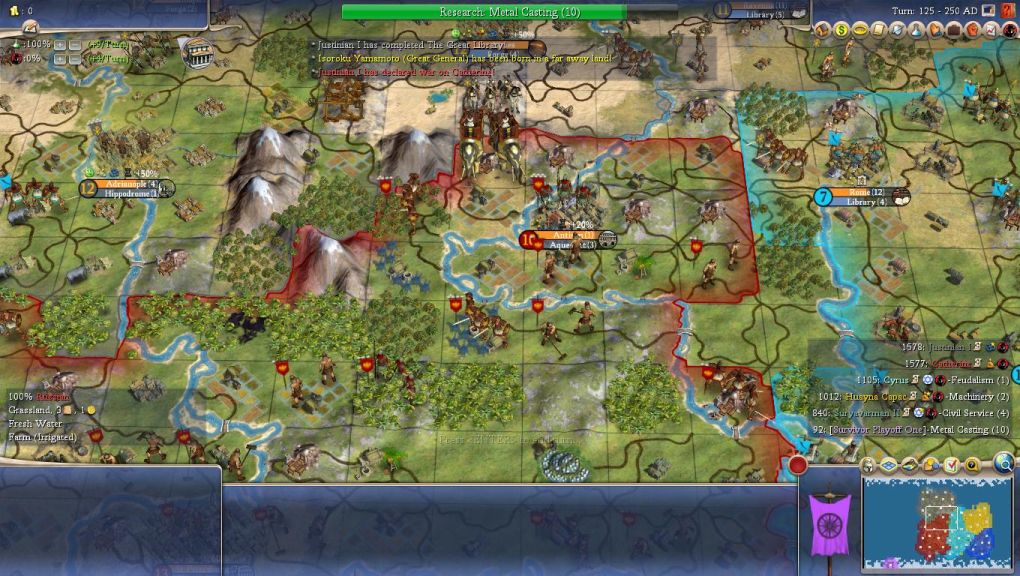
Whoa! Forget about that little tussel over in the east, this was serious business. Justinian declared war on Catherine, the two top dogs going at it. Could anyone manage a successful conflict against Catherine? To this point, Stalin was the only one who had survived a war against the tsarina. Justinian had a very large invasion force moving against Antium: 11 longbows, 19 swords, 9 axes, 6 spears, and 8 catapults. That was a lot of units. But Catherine had over two dozen units of her own on defense inside the city, which also had the hill defensive bonus. While I was watching those two slug it out over Antium, Huayna Capac declared war on Cyrus, going after the Persian cities in conquered Roman territory. Madness, nothing but madness all over the map! 
In the humongous battle fought over Antium, Catherine ultimately managed to hold the city. I think that two things made the difference there: the city being on a hill provided that little extra defensive bonus for the Russian longbows, and Catherine moved before Justinian in the randomness of turn order. This allowed some reinforcements to move into the city at a critical point in the fighting. Huge wars can sometimes turn on such minor details. Both leaders saw tremendous losses though:
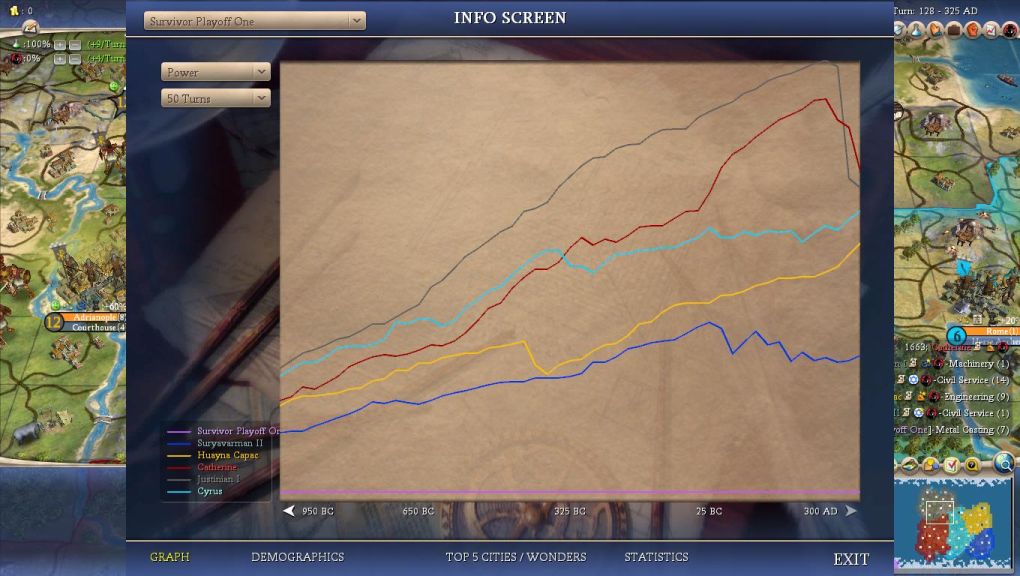
The massive bloodletting between the Byzantines and Russians drew them back towards the rest of the pack in military power. Cyrus and Huayna were a lot closer now. Huayna had been the first to research the Civil Service and Machinery combination, and he was upgrading all of his axes into maces at the moment. Unfortunately for Huayna, his main stack was just sitting on a hill on the border with Cyrus, not moving around or doing anything. I saw that happen before on occasion in these games, an AI stack seemingly getting lost with no idea what to do. I wonder what causes this? Good news for Cyrus, in any case. His offensive was proceeding nicely in Khmer territory:
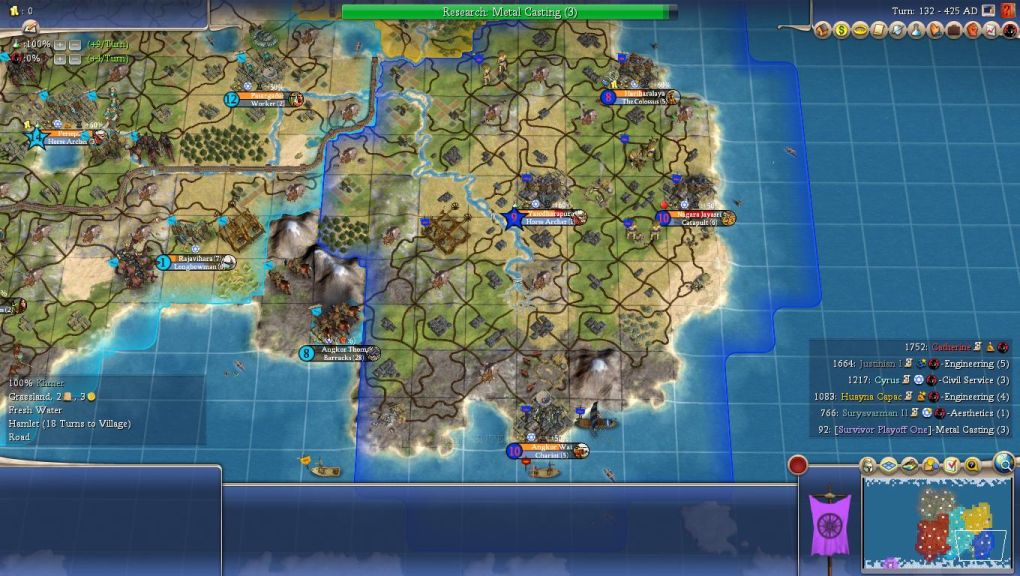
Angkor Thom was in Persian hands, and Suryavarman was reduced to a mere shell of a civilization. His military was in dire straights, and four cities wasn't enough to keep up with the production of Cyrus. If the Persian leader held firm and kept pushing his advantage, he could be emerging here as the leader to beat in this game. The ongoing stalemate in the west between Justinian and Catherine was exactly what Cyrus needed.
While Justinian might not have been making any progress against Catherine, he was completing wonders left and right in his territory. Justinian had built the last five wonders in a row: the Statue of Zeus, the Great Library, the Parthenon, the Colossus, and Shwedagon Paya. It's rare to see one leader land so many wonders in a row unless they have a huge tech lead, and that wasn't the case here. Possession of the Statue of Zeus might be particularly important if Catherine warred for an extended period with Justinian.
Catherine and Justinian ended their war after the Byzantines made another unsuccessful attempt to capture Antium. No surprise there: Catherine seems to be unbeatable on the battlefield in this competition. As their war was dialing down, the Persian vs. Incan conflict was heating up:

Cyrus attacked unsuccessfully at Huamanga, throwing away a fair-sized stack to no real purpose. Huayna had finally moved his main stack down off the hill where they stood in place for half a dozen turns, and the Incans were concentrating on Susa. They captured the city once, lost it to Cyrus on the same interturn, then retook it again. Cyrus was forced to call off his Khmer offensive for the moment, and he brought his main invasion force back into his territory in an attempt to regain Susa. Huayna's technological edge was helping him significantly here, as the Incans had maces and crossbows forming the bulk of their armies while Cyrus was only just finishing Metal Casting. Suryavarman's horse archers were able to sneak into Angkor Thom down in the deep south and recapture it back for the motherland. All the while, Incan maces were just slaughtering the melee-heavy Persian units, lots of swords and axes and spears. Cyrus had seen his fortunes totally reversed in the last ten turns. Huayna was on the point of passing him in score!
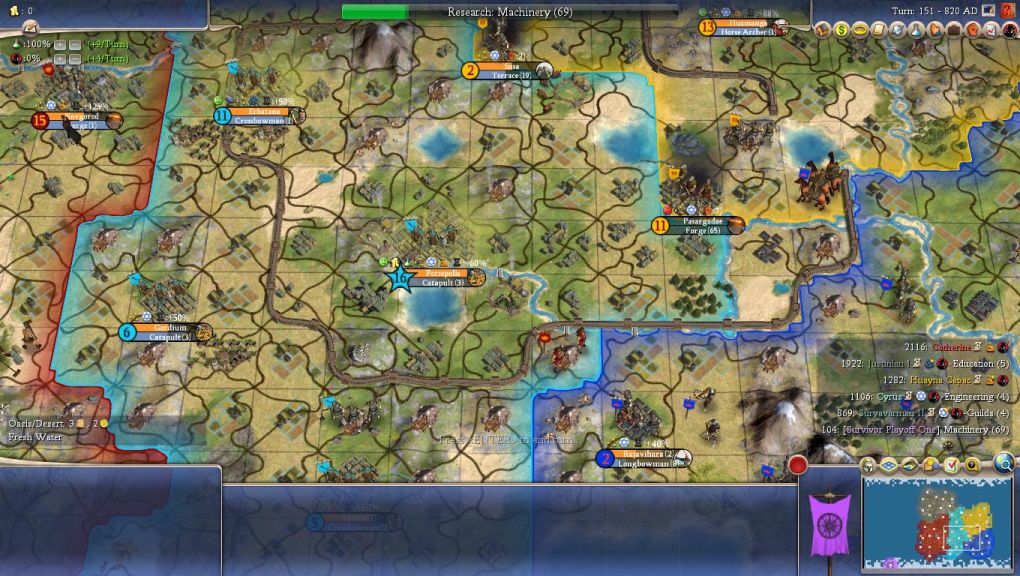
Cyrus lost two more of his eastern border cities on the same turn. Suryavarman took back the city of Rajavihara in the south, thus undoing all of the territorial damage in their war to date. Now the Khmer would be back on the offensive again, something not seen since the first days of the struggle. But the heavy lifting was being done almost entirely by Huayna Capac, who had been leveraging his superior military tech to great advantage. Trebuchets had been the main unit responsible for capturing Pasargadae, the second city of the Persian empire. Now it was in Incan hands, and Huayna appeared to have grasped the upper hand in their contest. Cyrus still had eight cities remaining, but the recent ebb and flow of the war suggested that things were slowly moving against him.
Hey, remember how Catherine will declare war on anyone, even other leaders with whom she has "Friendly" relations? This was in action again here, as Huayna Capac bought Catherine into the war against Cyrus.

I knew it was a purchased war declaration because Catherine didn't have any units on the Persian border when she declared. That's a dead giveaway, the AI is never subtle when they themselves are the ones invading. You can see it coming a mile away. Amazingly, Huayna bought Catherine into his war, and then cashed out with his own peace treaty on the very next turn! Rough news for poor Cyrus, as now he was facing the top leader in score, still also at war with Suryavarman. Ecbatana fell almost immediately, and with Russian knights now crusading for Catherine, the only question was how far she would want to keep pushing.
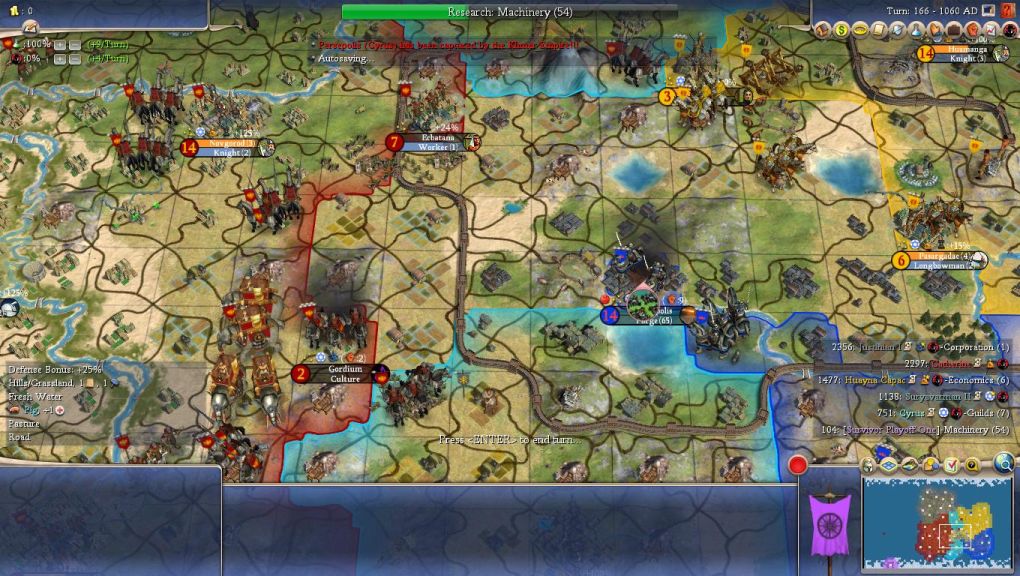
Oh dear.  Now it was just getting ugly. Catherine had moved south from Ecbatana and added Gordium to her burgeoning empire. In a shocking turn of events, Suryavarman managed to siege the Persian capital and actually take it with his knights. Yes, Suryavarman, the leader who looked left for dead as little as thirty turns ago! Unbelievable, now he was the one taking one of Cyrus' best cities. The Persians were left with two cities up in former Roman territory, and two unconnected cities in the deep south. Cyrus did not look to be long for this world. Huayna had made a mistake signing peace earlier, he should have stayed in this war to capture more of the spoils. His loss.
Now it was just getting ugly. Catherine had moved south from Ecbatana and added Gordium to her burgeoning empire. In a shocking turn of events, Suryavarman managed to siege the Persian capital and actually take it with his knights. Yes, Suryavarman, the leader who looked left for dead as little as thirty turns ago! Unbelievable, now he was the one taking one of Cyrus' best cities. The Persians were left with two cities up in former Roman territory, and two unconnected cities in the deep south. Cyrus did not look to be long for this world. Huayna had made a mistake signing peace earlier, he should have stayed in this war to capture more of the spoils. His loss.
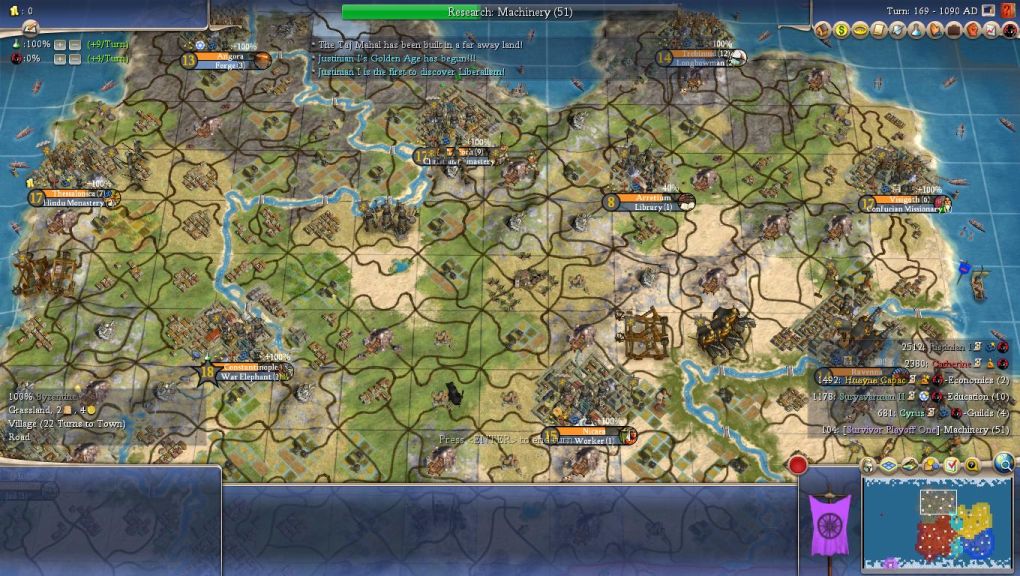
Despite the cities captured from Cyrus, Catherine was actually only second in score. The leader was Justinian, who had somehow found himself in the role of tech leader. Justinian built the Taj Mahal for a free Golden Age, and he was also the first to Liberalism, where he took Military Tradition as his prize. If Catherine and Justinian never fought again, they would be all but certain to claim the top two spots and move onto the championship match. I wasn't at all certain that would be the case, however, as Catherine hated Justinian with an intense passion for attacking her earlier. Obviously nothing would happen for now while the war continued against Cyrus, but after that... well, this was Catherine, after all. There was no one in this game more likely to hold a grudge.
The two Persian cities in the far south were the next ones to fall, both of them going over to Catherine. There was a sizable column of Khmer knights heading for the same prizes, Catherine just didn't give Suryavarman a chance to act. She ran them over too quickly. The city of Rome was the next to be taken, again by Catherine. She was out for blood now, and nothing was going to get in her way. Cyrus huddled in his final remaining fortress, desperately hoping for some miracle, some delivery from his fate. His prayers went unanswered.

Somehow Cyrus had managed to recapture Pasargadae and hold it for a couple of turns, which is why this was the location of his final stand. I actually thought he had died at Cumae, and was sitting around waiting for the death message to appear, when I realized that there was one more Persian city remaining. As for Cyrus, he was actually looking to be a strong contender for one of the top spots until Huayna Capac declared war. The Incans not only threw a monkey wrench into the planned conquest of Suryavarman, Huayna also bribed Catherine into the war as well, and that was the ultimate death knell for Persia. Cyrus had no chance when forced to face so many opponents at once. In the larger picture, we were now down to the three AI leaders who had won their opening round games, and Justinian, arguably the strongest of the runner up leaders. I don't think that it was a coincidence that the same AI personalities were shouldering their way to the top once again.

From the bird's eye view in the sky, the continent looked to be divided neatly into four quarters. That could be misleading though, as Justinian and Catherine both had cities of much larger sizes than their rivals, and both of them also had more total number of cities to boot. The two of them were virtually dead even in score, although Catherine would surely pull ahead in time since she had 16 cities to Justinian's 11 cities. The Russian conquests only needed time to grow and build their infrastructure. It was also important to keep in mind the tech situation, where Justinian was ahead by about six techs on Catherine and about ten techs on Huayna/Suryavarman. The tech gap felt larger because it lay across a major divide in military gear. Justinian had Rifling tech, and that meant rifles and cavs everywhere. His power was spiking enormously on the power graphs, and someone was about to get their behind thoroughly kicked. Catherine wasn't far behind in number of techs, but she lacked Gunpowder and Repaceable Parts and Rifling. Was Justinian going to hit her at the absolute perfect moment before the Russians had the chance to modernize, or was the hammer going to fall on one of the more backwards leaders?

Ah, it looked like Justinian wanted to play conquistador and go after the Incans. Catherine really dodged a bullet here, she was still neglecting her military techs to go after the Scientific Method to Physics research path. Justinian could have hit her with masses of cavs against longbows and diced up the Russian cities something fierce. Instead, it was Huayna Capac who was about to suffer the wrath of god. The main Byzantine stack had about 25 cavs and a dozen rifles inside it... facing off against a medieval army of Incan knights and crossbows. It was Francisco Pizarro all over again.
Huayna tried to attack the Byzantine city of Rome, his crossbows in the invasion stack dying horribly against the defending rifles. On the flip side, Justinian had no trouble rolling right over the defenders of Neapolis. This was getting ugly in a real hurry.

Justinian's insistence on bombarding down cultural defenses at every city was the only thing holding his offensive back. He could have run over the whole Incan empire in a few turns if he hadn't been chained to that slow progress by his AI logic circuits. This was giving Catherine the chance to catch up with her own military research, but I was beginning to wonder if that would even matter. Justinian was the clear GNP leader, and he also held the score and military edge as well. Perhaps he was simply beginning to hit critical mass and reach runaway status. If the other leaders didn't do something soon, no one would be able to stop him.

There we go! Catherine attacked Justinian while the flower of the Byzantine army was off in Incan territory, an opportune moment to begin the offensive. However, I thought that Catherine should have waited a couple more turns. She had only just discovered Rifling tech on this very turn, and she hadn't had a chance to upgrade her units yet. Cathy was down at 80% gold, setting aside income for upgrades, but those old units hadn't been outfitted with guns just yet. I figured that she would have a major advantage once all of the old knights were upgraded to cossacks, since the AIs all love to build Mounted units and cossacks get that sweet +50% bonus against enemy cavs. In any case, the die was now cast. We were about to see who would emerge as the top dog between Catherine and Justinian.
The Russian vs. Byzantine war began with Justinian capturing the city of Ecbatana, a former Persian city right on Catherine's eastern border. Justinian could move right up next to it through his use of Open Borders with Suryavarman. Catherine was frantically upgrading her old units, not even trying to make progress on further tech. Catherine responded by taking Iconium, a Byzantine city right on their mutual border, but Justinian then struck back by taking Gordium (another former Persian city). Russian cossacks were winning their individual matchups, but there weren't enough of them on the field yet. Justinian was also pushing further forward into Incan territory, occupying the city of Machu Picchu. Huayna was down to only four cities left. Meanwhile, Cathy had taken Ecbatana back again, as she continued to trade units at a furious rate along the Byzantine border. There were just SO MANY Byzantine units rolling around, including cannons now appearing in large numbers. Even as the border cities continued to be traded on an almost turn by turn basis, a new wild card was thrown into the mix:
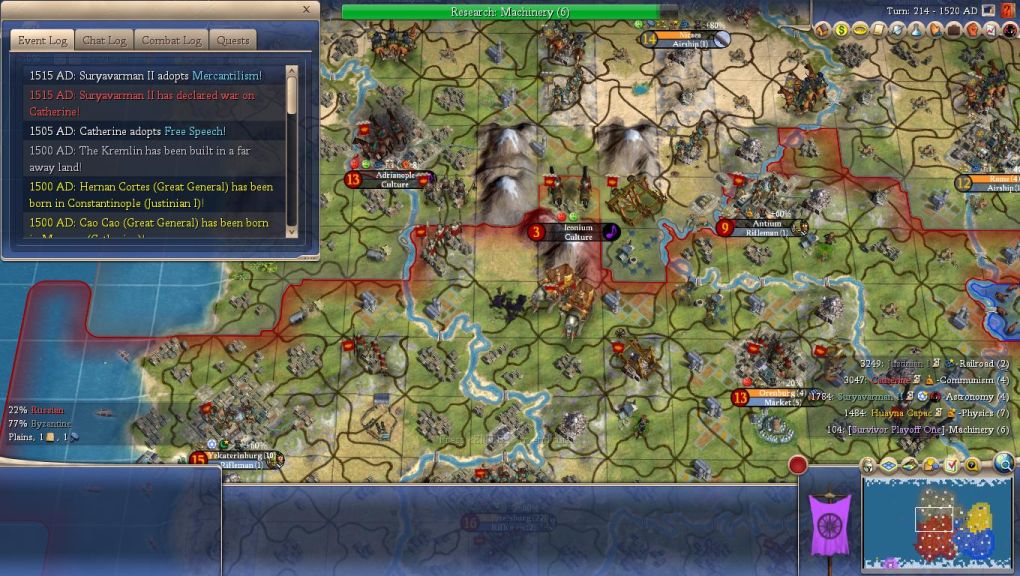
Suryavarman entered the war as well, on the side of Justinian. The Khmer were fairly weak and didn't have any units stronger than knights, but in such a close conflict their intervention might make a critical difference. Even as Catherine was able to capture the important Byzantine city of Adrianople, she had lost Tarsus to Justinian and Ecbatana was under siege yet again. For whatever reason, it was the Persian conquests of Catherine that kept drawing the most attention from the other leaders.
With the passage of time, it was becoming more and more clear that things were not going well for Catherine. Her invasion force was wiped out as it tried to push deeper into the Byzantine core. Justinian was able to rally his military and recapture first Adrianople, then Iconium. All of the former Persian cities were now in either Byzantine or Khmer hands, and the offensive against the Incans continued to grind slowly forward. Suryavarman even had the Russian core city of Novgorod under siege now, using a combination of knights and trebuchets. The bar graphs told the grim story:

Catherine LOSING a war?!  What madness was this? The champ is down! The Russian is hurt! "You see? You see? He's not a machine, he's a man, he's a man!" Err woman, in this case. But the point remained: Catherine was losing, and things were starting to look grim. Justinian was too strong, and Suryavarman wasn't making things any easier. The Russians needed help to turn this around... but where was it going to come from? Huayna was totally crippled and suffering even more heavily. Everyone else was dead. There was no escape from this situation.
What madness was this? The champ is down! The Russian is hurt! "You see? You see? He's not a machine, he's a man, he's a man!" Err woman, in this case. But the point remained: Catherine was losing, and things were starting to look grim. Justinian was too strong, and Suryavarman wasn't making things any easier. The Russians needed help to turn this around... but where was it going to come from? Huayna was totally crippled and suffering even more heavily. Everyone else was dead. There was no escape from this situation.
Antium was down, Orenburg went down next. Justinian had called off his attack in Incan territory for the moment, just holding his current conquests and sending all of the new units south into Russia. Catherine did manage to secure peace with Suryavarman, but the damage already appeared to have been done. Justinian had finished Assembly Line research, he had railroads connecting all of his cities, and infantry forming the backbone of the Byzantine armies. Factories and coal plants allowed most cities to complete a unit every turn. Catherine was only just beginning research into Steam Power, nowhere close to infantry or machine guns. She was also suffering terribly from Statue of Zeus enhanced war weariness, a full 8 unhappy faces in the city of Moscow. Like so many AI wars, this one wasn't fast, but it was marching inexorably onwards.
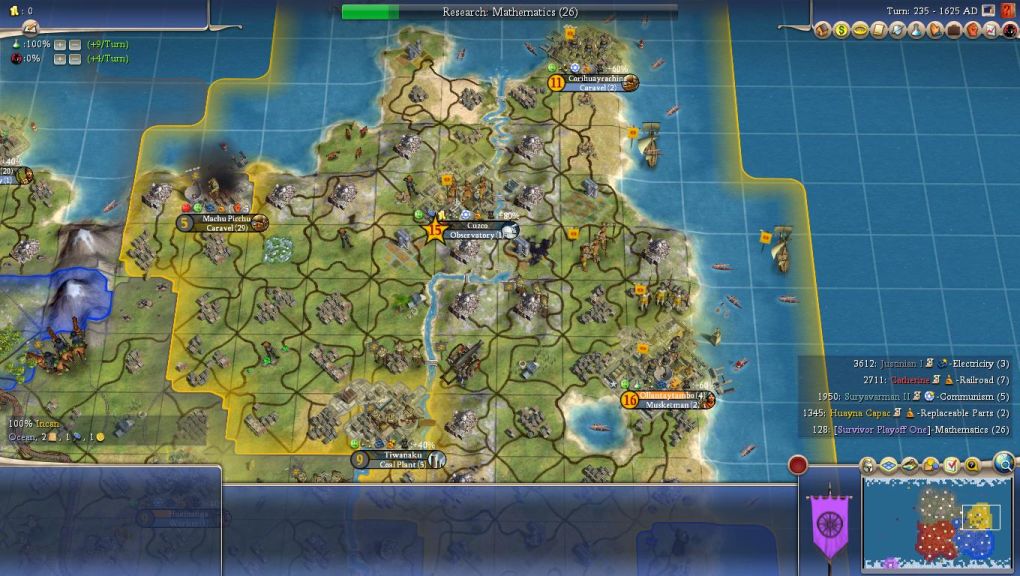
These three cities were all that was left of Incan territory. Huayna was only clinging to life by virtue of the shared war with Catherine. He wouldn't last very long if the full attention of Justinian were to fall over here in the east.

As we closed in on Turn 250, the outer ring of Russian cities had all fallen into enemy hands. The route forward to Moscow was now open. By the way, there was one thing that potentially could have reigned in Justinian: he didn't have any oil! That source directly north of St. Petersburg was the closest location, and that had been well within Russian territory for most of the game. If Catherine had been able to hold out longer, that could have been a huge deal. As it was, Justinian hadn't been able to field modern ships or tanks despite having the technology to do so. He was now finally able to connect the resource, and begin rolling some armored vehicles off of the assembly lines. (In the absence of oil, the AI built marines in huge numbers, which was a bizarre thing to see out on the battlefield.) At least, that's what I thought he would do, as dozens of turns passed without connecting that oil. AI management of workers is not exactly the best.
The war ground on and on without rest. When it has an overwhelming military lead, the AI tends to feel something like a huge steamroller lumbering across the landscape. It's slow, it's ponderous, but there's no resisting it. Eventually it will crush everything in its path. One by one, Catherine's cities were being taken. There were plenty of desperate heroics on all sides, however nothing changed the grim statistics in this war of attrition. The side with superior units and a stronger production base will eventually overrun its opponent. Justinian was almost impossibly stupid, and his failure to connect his own oil resource dragged this game out tediously. If he would just build a darned oil well, he would be able to build tanks and bombers and destroyers, and this game would be over in a jiffy. Instead, we were stuck in this bizarre equilibrium where Justinian's lack of oil allowed Catherine to stabilize things and create an effective stalemate despite her technological backwardness and inferior production base. I clicked through many, many turns without much happening.
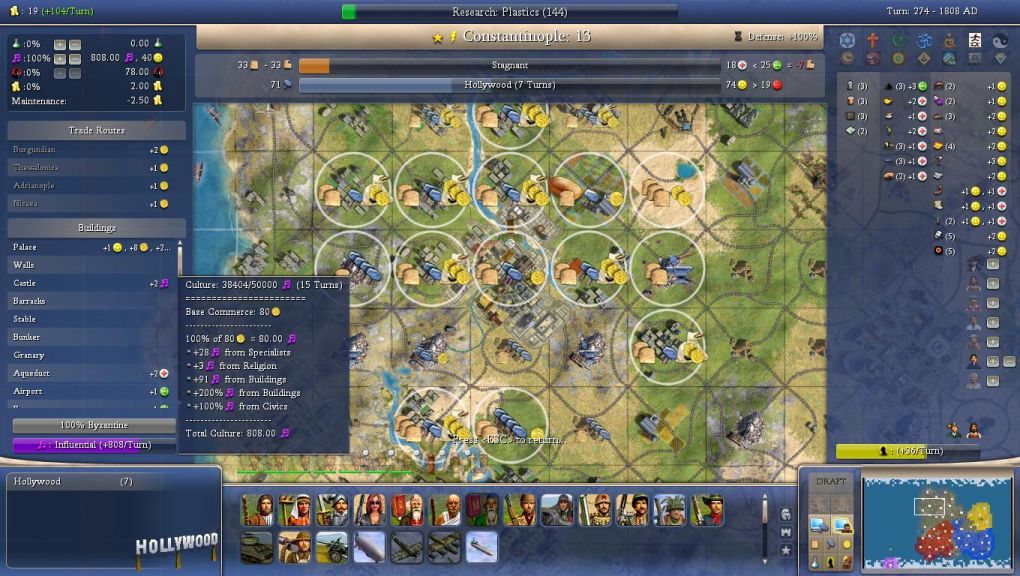
This was certainly something new. Justinian stopped researching more techs and started pursuing a Cultural victory. He needed about 50 more turns at the current rate if he wasn't able to speed it up faster. And the idiot still didn't have his oil connected!  Plus he'd chosen to stop teching when his research was set to Plastics, which was the one thing which would have enabled Justinian to connect his sea-based oil resource. Sigh. Any hope of a speedy finish to this game was not in the cards.
Plus he'd chosen to stop teching when his research was set to Plastics, which was the one thing which would have enabled Justinian to connect his sea-based oil resource. Sigh. Any hope of a speedy finish to this game was not in the cards.
For some unknown reason, Justinian pulled most of his units away from Catherine and sent them after Huayna instead. He managed to take the Incan capital, and began to advance on the final remaining two cities. This was when Justinian finished the United Nations and held the first Secretary General vote.
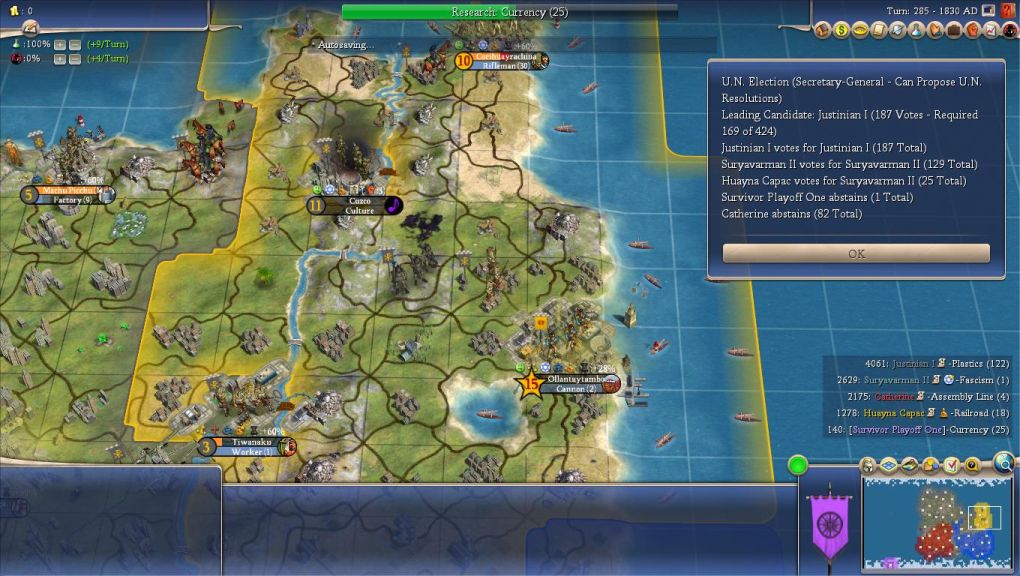
Justinian's population was strangely low given all of the territory under his control. His largest city was only size 12, despite having something like 80 happiness in every city from running 100% culture slider. The fool had built so many workshops that all of his cities had starved down to tiny sizes. What a moron. I tell you, the AI never ceases to amaze me with their ability to sabotage themselves. This meant that there was basically no chance of winning through the United Nations. Justinian and Suryavarman would split the vote, and neither would come anywhere close to the necessary 62% of the total. Another possible avenue to victory denied.
Justinian finally completed an oil well on Turn 288. It was not the one on the Russian border, it was over in former Persian territory. Bravo, well done AI worker routines. Only took you 55 turns to build an improvement on the single most important modern era resource. Anyway, the clock finally struck midnight for Huayna Capac shortly thereafter:

This took Justinian to 55% land area, about ten percent short of what he needed for Domination. It was clear he was going to win the game, the only mystery was what victory condition the Byzantines were going to achieve. Unfortunately for a fast ending, Justinian was building Wealth in nearly every city to fuel his strange pursuit of Cultural victory. This meant that he was not building very many units for his war against the Russians. There was no peace with Catherine, but the ongoing struggle wasn't being contested very heavily either. Mostly both sides kind of sat around not doing much. It wasn't all that interesting to watch, I have to say.
Eventually Suryavarman declared war on Catherine again. I guess he was worried that Catherine might catch up to him in score, and so the Khmer leader took steps to make sure that wouldn't happen. Novgorod fell on Turn 300; Justinian was exactly 31 turns away from winning by culture on the same turn. Moscow was next:

What was up with that "election has been canceled" message? I'm not sure I've ever seen that before. Justinian's AI targeting seemed to be much improved without having those Incan cities off in the far east to distract him. The long-awaited tanks helped a great deal too. Catherine now had Assembly Line tech and her own infantry, but it was too little, too late. Justinian sat at 60% land area, and it looked as though he'd hit Domination before he managed to finish off his slow cultural burn. As expected, Rostov fell a few turns later, and that put Justinian over the top:
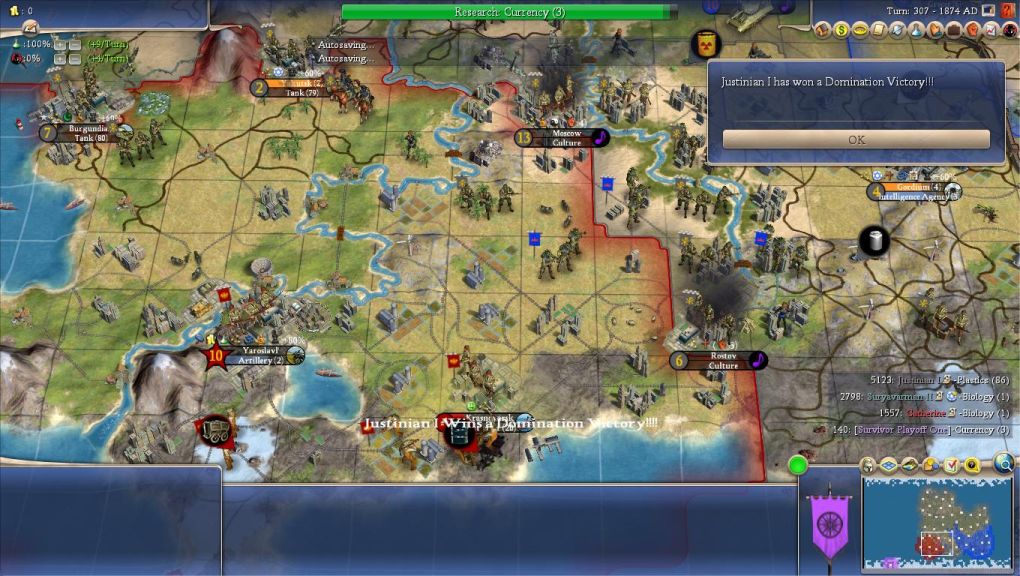
Domination on Turn 307, most of the world flying the gray banners of Byzantium. I checked on the Cultural victory attempt, and Justinian hadn't managed to speed it up since my last observation. His third city would have gone Legendary on Turn 331, or in another 24 turns. We had another near miss on culture. Of course, if Justinian hadn't stopped researching and building units, or if he had connected his oil resource 50 turns sooner, then he likely would have won by Domination dozens of turns faster. That might have been enough to end the game with Catherine still leading Suryavarman in score. The delay was very much to Suryavarman's advantage.
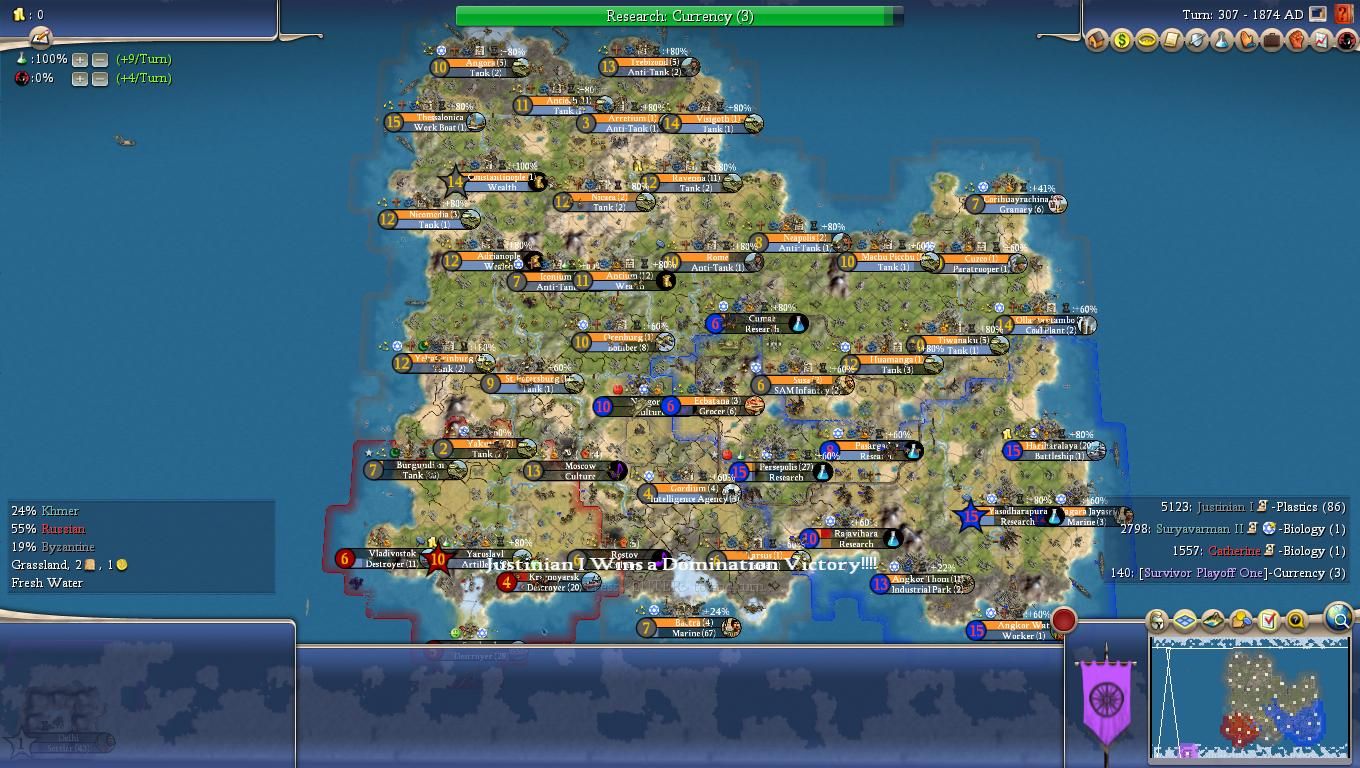
One of the things that always bothers me when selecting these random maps is trying to ensure that they're reasonably fair to the different AI leaders. I think that this one was decently close enough, as a glance at the Turn 68 picture at the end of the landgrab shows each of the civilizations in fairly even situations. Still, I wonder on a map like this if it made things too easy for the western leaders and too difficult for the eastern ones in the end. Looking back on what happened, there were a couple of key turning points. One of the biggest was the placement of Augustus in the middle of the map. He more or less had a giant target painted on his face from before the game even began, and that central spot all but ensured that the Romans would be the first to go. (I do not consciously place these leaders on the maps, I simply roll random ones until they come out roughly even. Augustus just suffered from bad luck to get that spot.) In any case though, Augustus was likely to be the target of an early dogpile, and a key issue was who would reap the most from the spoils afterwards. Justinian was the big winner there, taking three cities in the north, and cities that were very safe from future attack in a way that Cyrus' acquisitions were not. This was probably the biggest factor in snowballing Justinian ahead.
I think the other biggest factor in the game's outcome was the strange attack by Suryavarman against Cyrus. Those two shared a religion, and the logical next war in the east would have been a Persia + Khmer coalition together against the Buddhist Incans. That likely would have seen Cyrus pick up more cities and emerge as a true powerhouse to counterbalance Justinian and Catherine. As it was, Cyrus nearly pulled it off, making great progress in his war against Suryavarman until Huayna intervened. Because of the way things shook out, however, the strongest of the three eastern leaders (Cyrus) wound up fighting 1 versus 2 against the weaker leaders (Suryavarman and Huayna). This had the net effect of dragging all three of them down together. The game winner was therefore the one who came out on top in the duel between Justinian and Catherine, and that was won convincingly by Justinian. He actually never even used his cataphracts in this game! All of those wonders, on the other hand, did seem to help a lot. Especially the Statue of Zeus. Catherine's long delay of military techs was another major reason for her downfall. She researched the Constitution/Democracy line and the Scientific Method/Physics line before getting Gunpowder! Justinian had rifles and cavs all the while, and by the time Cathy upgraded her military tech, it was simply too late.
Finally, as much as we sometimes think that geography is destiny in these games, the AI will occasionally throw out a bizarre result. I think Catherine pretty clearly had the best starting position in this game, and yet she won't be advancing to the championship, while tiny little boxed-in Suryavarman will be moving on as the runner up. These games are good at throwing out surprises.
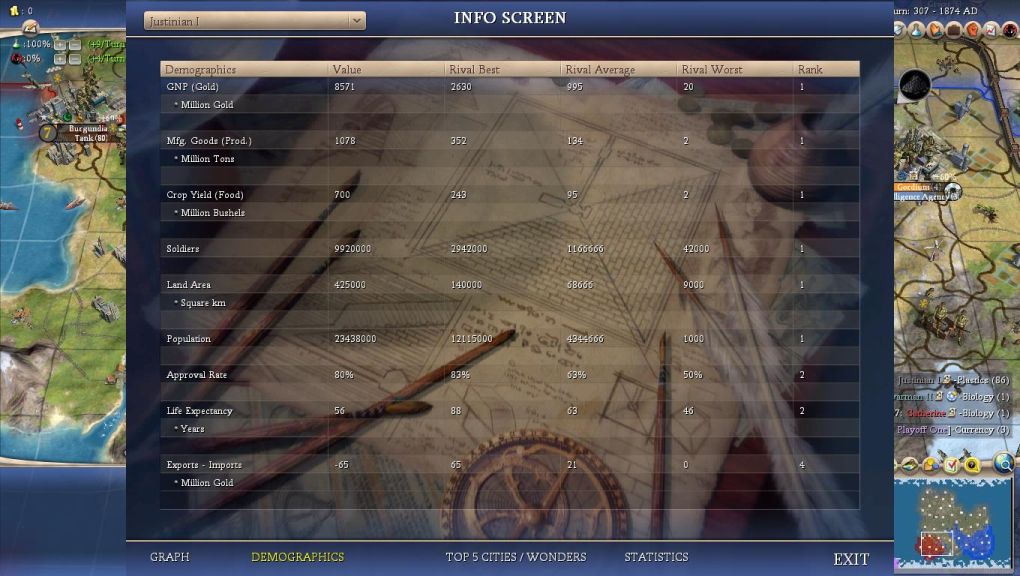
The ending Demographics for Justinian. He was dominant compared to the other leaders in this game, but not compared against some of the results we've seen in other games. The population figure in particular was very low for someone who controlled 65% of the map, again due to having so many small cities. Catherine's Domination victory from Game Seven had 72 million people, for example. Weird empire management.
Final Standings
1) Justinian
2) Suryavarman
3) Catherine
4) Huayna Capac
5) Cyrus
6) Augustus
Justinian and Suryavarman move on to the final game. We'll see each of them one last time, when the AI leaders compete for the ultimate championship. Catherine can take some small solace in escaping with her skin intact, which is more than most of the competitors can say. She's finished now and won't be moving on further, but at least she did survive. Two more playoff games left to go, we still need to find out who will be joining Justinian and Suryavarman in that last game. Stay tuned.



